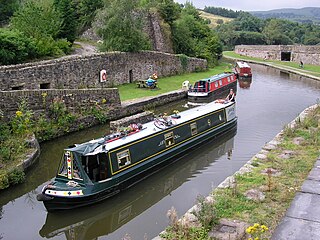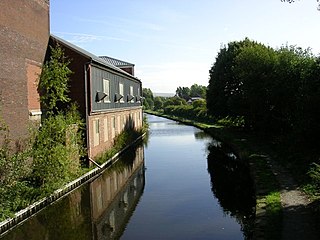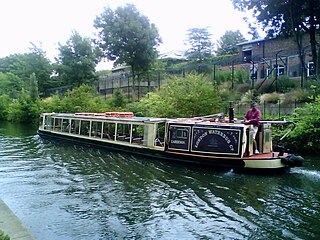
The Crick Boat Show & Waterways Festival is an event that has been held annually at Crick Marina in Northamptonshire, England, since its inception in 2000.

The Crick Boat Show & Waterways Festival is an event that has been held annually at Crick Marina in Northamptonshire, England, since its inception in 2000.
The show takes place every year on the Grand Union Canal at Crick Marina. This is located on the Leicester Line, to the north of Crick Tunnel, on the level section of canal between the tops of the Watford flight and the Foxton flight. The site is close to junction 18 on the M1, and the event has traditionally taken place on the last bank holiday weekend in May. [1]
The show was first held in 2000, [2] when it was organised by British Waterways, and has been held every year since then. Responsibility for its organisation was passed to Waterways World Magazine in 2011, where it has remained ever since in partnership with the Canal & River Trust and Crick Marina.
The event is the focal point of the inland boating calendar and provides the opportunity for boat-builders and sellers to promote new and second-hand boats to visitors considering buying a boat. Every conceivable type of product and service for canal boats is represented by the exhibitors, ranging from equipment to finance and insurance. In a dedicated lecture theatre, a series of free seminars are held throughout the event, covering such topics as boat maintenance, living afloat and boat-buying on a budget.
Free boat-trips along the Grand Union Canal are provided – but must be booked upon arrival at the show – and boat-handling courses are available for an additional fee. [3]
The event is also billed as a 'Waterways Festival', with continuous live music, a large beer festival (organised by The Wheatsheaf public house from the local village) with up to 40 real ales, food and crafts stalls and a range of children's activities broadening its appeal. The live music has included headline performances by recording artists such as Toyah Wilcox (2014), Hazel O’Connor (2015) and Tom Robinson (2016). But also features well-known tribute acts such as T-Rextasy (2017) and Abba Revival (2018).
The 2017 show was attended by 27,000-plus people [4] and included around 40 'boats on show' among nearly 200 exhibitors.
A well established tradition of the event is the 'Favourite Boat in Show' award, which is voted for by show visitors and presented to the winner on the Monday. The visitors' choice for the most admired narrowboat in 2019 was Two Hoots by Boating Leisure Services. The widebeam that attracted the most votes is 70ft Brigantine by Finesse Boats. [5]
Previous winners are as follows:
2018
2017
2016
2015
2014
2013
2012
2011
2007
2000

Barge nowadays generally refers to a flat-bottomed inland waterway vessel which does not have its own means of mechanical propulsion. The first modern barges were pulled by tugs, but nowadays most are pushed by pusher boats, or other vessels. The term barge has a rich history, and therefore there are many other types of barges.

A towpath is a road or trail on the bank of a river, canal, or other inland waterway. The purpose of a towpath is to allow a land vehicle, beasts of burden, or a team of human pullers to tow a boat, often a barge. This mode of transport was common where sailing was impractical due to tunnels and bridges, unfavourable winds, or the narrowness of the channel.

The Grand Union Canal in England is part of the British canal system. It is the principal navigable waterway between London and the Midlands. Starting in London, one arm runs to Leicester and another ends in Birmingham, with latter stretching for 137 miles (220 km) with 166 locks from London. The Birmingham line has a number of short branches to places including Slough, Aylesbury, Wendover, and Northampton. The Leicester line has two short arms of its own, to Market Harborough and Welford.

A narrowboat is a particular type of canal boat, built to fit the narrow locks of the United Kingdom. The UK's canal system provided a nationwide transport network during the Industrial Revolution, but with the advent of the railways, commercial canal traffic gradually diminished and the last regular long-distance transportation of goods had virtually disappeared by 1970. However, some commercial traffic continued. From the 1970s onward narrowboats were gradually being converted into permanent residences or as holiday lettings. Currently, about 8580 narrowboats are registered as 'permanent homes' on Britain's waterway system and represent a growing alternative community living on semi-permanent moorings or continuously cruising.

The Calder and Hebble Navigation is a broad inland waterway, with locks and bridgeholes that are suitable for 14-foot-wide (4.3 m) boats, in West Yorkshire, England. Construction to improve the River Calder and the River Hebble began in 1759, and the initial scheme, which included 5.7 miles (9.2 km) of new cuts, was completed in 1770 and has remained navigable since it was opened. Significant improvements were made, including the Salterhebble branch to Halifax, opened in 1828, and ever-longer cuts to bypass river sections. Trade was assisted by the opening of the Rochdale Canal in 1804, which provided a through route from Sowerby Bridge to Manchester. There were plans to abandon the river sections completely in the 1830s, but these were modified as the needs of mill owners and other riparian landowners were recognised.

The Aire and Calder Navigation is the canalised section of the Rivers Aire and Calder in West Yorkshire, England. The first improvements to the rivers above Knottingley were completed in 1704 when the Aire was made navigable to Leeds and the Calder to Wakefield, by the construction of 16 locks. Lock sizes were increased several times, as was the depth of water, to enable larger boats to use the system. The Aire below Haddlesey was bypassed by the opening of the Selby Canal in 1778. A canal from Knottingley to the new docks and new town at Goole provided a much shorter route to the River Ouse from 1826. The New Junction Canal was constructed in 1905, to link the system to the River Don Navigation, by then part of the Sheffield and South Yorkshire Navigation.

The canal network of the United Kingdom played a vital role in the Industrial Revolution. The UK was the first country to develop a nationwide canal network which, at its peak, expanded to nearly 4,000 miles in length. The canals allowed raw materials to be transported to a place of manufacture, and finished goods to be transported to consumers, more quickly and cheaply than by a land based route. The canal network was extensive and included feats of civil engineering such as the Anderton Boat Lift, the Manchester Ship Canal, the Worsley Navigable Levels and the Pontcysyllte Aqueduct.

The Canal Museum, formerly known as the "National Waterways Museum Stoke Bruerne" and "The Canal Museum at Stoke Bruerne", is a canal museum located next to the Grand Union Canal just south of the Blisworth Tunnel, near the village of Stoke Bruerne in Northamptonshire. It is about 10 miles (16 km) north of Milton Keynes and 7 miles (11 km) south of Northampton near junction 15 of the M1 motorway.

The Llangollen Canal is a navigable canal crossing the border between England and Wales. The waterway links Llangollen in Denbighshire, north Wales, with Hurleston in south Cheshire, via the town of Ellesmere, Shropshire. The name, which was coined in the 1980s, is a modern designation for parts of the historic Ellesmere Canal and the Llangollen navigable feeder, both of which became part of the Shropshire Union Canals in 1846.

The Ashton Canal is a canal in Greater Manchester, England, linking Manchester with Ashton-under-Lyne.

The canals of the United Kingdom are a major part of the network of inland waterways in the United Kingdom. They have a varied history, from use for irrigation and transport, through becoming the focus of the Industrial Revolution, to today's role of recreational boating. Despite a period of abandonment, today the canal system in the United Kingdom is again increasing in use, with abandoned and derelict canals being reopened, and the construction of some new routes. Canals in England and Wales are maintained by navigation authorities. The biggest navigation authorities are the Canal & River Trust and the Environment Agency, but other canals are managed by companies, local authorities or charitable trusts.

A houseboat is a boat that has been designed or modified to be used primarily as a home. Some houseboats are not motorized, because they are usually moored, kept stationary at a fixed point and often tethered to land to provide utilities. However, many are capable of operation under their own power. Float house is a Canadian and American term for a house on a float (raft); a rough house may be called a shanty boat. In Western countries, houseboats tend to be either owned privately or rented out to holiday-goers, and on some canals in Europe, people dwell in houseboats all year round. Examples of this include, but are not limited to, Amsterdam, London, and Paris.
The IWA National Festival & Boat Show run by the Inland Waterways Association is one of the key annual events on the United Kingdom's inland waterways. Generally referred to as the "National" it serves several functions:

Dudley Tunnel is a canal tunnel on the Dudley Canal Line No 1, England. At about 3,172 yards (2,900.5 m) long, it is now the second longest canal tunnel on the UK canal network today.. However, since the Dudley Tunnel is not continuous this status is sometimes questioned:.

The Stainforth and Keadby Canal is a navigable canal in South Yorkshire and Lincolnshire, England. It connects the River Don Navigation at Bramwith to the River Trent at Keadby, by way of Stainforth, Thorne and Ealand, near Crowle. It opened in 1802, passed into the control of the River Don Navigation in 1849, and within a year was controlled by the first of several railway companies. It became part of the Sheffield and South Yorkshire Navigation, an attempt to remove several canals from railway control, in 1895. There were plans to upgrade it to take larger barges and to improve the port facilities at Keadby, but the completion of the New Junction Canal in 1905 made this unnecessary, as Goole could easily be reached and was already a thriving port.

The Horseboating Society is a national society, with the primary aim being the preservation and promotion of Horseboating on the canals of Great Britain. The Society was founded on 19 January 2001 at the Ellesmere Port Boat Museum, and it is the only organisation in the UK solely dedicated to horseboating.

Several private boat companies operate services which provide Transport on the Regent's Canal. The services run along the Regent's Canal in London, England, UK, and are open to the public. They provide both leisure cruises and regular scheduled "water bus" services along the canal between Little Venice, London Zoo and Camden Lock.

Hadar is a replica of a small Northwich narrowboat of the Star Class originally built for the Grand Union Canal Carrying Company (GUCCCo.) by W.J. Yarwoods of Northwich. She was built by Roger Fuller Boatbuilders Ltd of Stone, Staffordshire, and completed in 2007, and painted by Tina Paramore.

A widebeam is a canal boat built in the style of a British narrowboat but with a beam of 2.16 metres or greater.

Braidbar Boats are a narrowboat building company based at Lord Vernon’s Wharf on the Macclesfield Canal at Poynton, Cheshire.